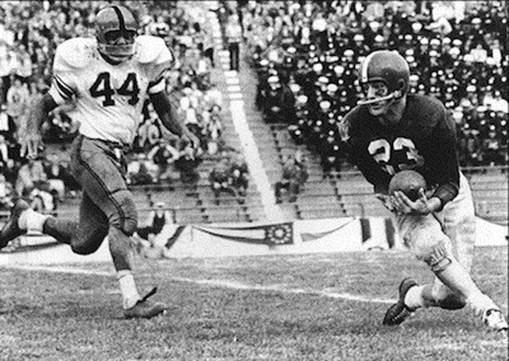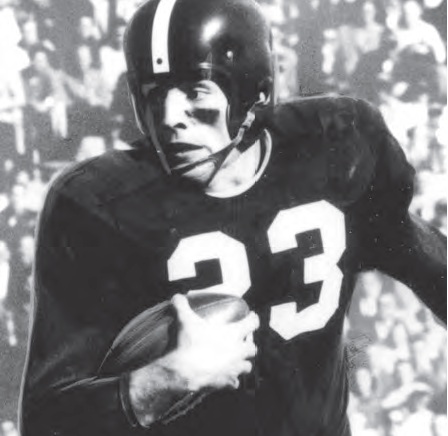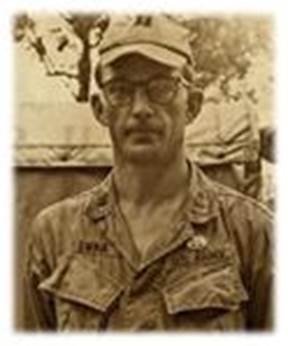

JIM SWINK, UNDERSTATED HERO
HELMET HUT NEWS/REFLECTIONS October 2016:
JIM SWINK, UNDERSTATED HERO
By Dr. Ken
On the eve of the start of
the Presidential Candidate
Debates of 2016, current
events that have highlighted
the cultural, political, and
social turmoil of our times
have no doubt stimulated
wistful thoughts of a
simpler and more genteel era
for those who enjoyed their
adolescence during the 1950s
and ‘60s. My teen years came
in the late ‘50s to
mid-1960s and few would call
the last half of the Sixties
“simpler and more genteel”
as anti-war protests, civil
rights unrest, and social,
political, and cultural
upheaval highlighted what
seemed to be every day’s
news. Yet the “psychological
environment” produced by the
game of football seemed to
have a calming if not
stabilizing effect on much
of the nation, in part
reflecting the relative
innocence of the1950s. By
the end of the Sixties,
football itself would be a
bit of a battleground with
some college campuses
hosting heated debates about
the sport’s perceived
brutality, relevance,
war-like analogies, and
“dehumanization.” Without
meaning to sound
insensitive, and expressing
opinions that are solely
those of this author and not
necessarily reflective of
HELMET HUT
or other staff members,
recalling and re-reading
numerous accounts of college
campus and football related
protests and their
underlying reasoning and
specific complaints make one
think, or at least make me
think, “What a waste!” To
know that careers were
ruined and choices were made
to forfeit scholarship money
and the loss of being able
to play a game every
involved athlete no doubt
loved because they believed
that their “personal freedom
was violated” when asked to
insure that their hair did
not protrude beyond the
bottom of their helmet, or
that their “civil rights
were violated and cultural
traditions disrespected”
because the team rule
forbade facial hair seems
short-sighted from the
perspective of one of my
age. I can recall that even
in the late 1960s, feeling
as if there were many
aspects of athletics and
“just life” that were
forever altered from the
dominant tenure of the
previous decade.
If ever a reminder of “all
that was right” about 1950s
football was needed, Jim
Swink is the embodiment of
that construct. He grew up
in Sacul, Texas, the son of
a logger and his wife who
both fell to illness when
Jim was thirteen years of
age. He moved in with a
couple in the nearby East
Texas town of Rusk where his
athletic abilities became
apparent. He was an All
State football player and
All District in both
football and basketball. He
was chosen for the Texas
High School All-Star
Basketball Team his senior
year and was named the
game's Most Valuable Player.
Swink vs Jim Brown in
the January 1, 1957
Cotton Bowl. It isn’t
often that two great
College Football Hall of
Fame members get to face
off
He entered Texas Christian
University in part because
of a relationship he
developed with head football
coach Abe Martin, a folksy,
country gentleman with whom
Swink felt very comfortable.
The lean 6’1”, 185 pound
back had obvious speed but
ran with deceptive power
that was obvious in his 1954
sophomore season when TCU
made the decision to play a
sophomore laden team and
finished at 4-6. Martin
parlayed the experience
gained by those youngsters
into a 9-1 regular season
finish in 1955, a close and
heartbreaking 14-13 loss to
Mississippi in the Cotton
Bowl, and a number five
end-of-season ranking. There
were a number of excellent
players on the squad
including future New York
Giants back-up quarterback
and Texas high school
coaching great Charles
“Chuck” Curtis but it was
Swink that was the team’s
engine. On but 157 carries
the “Rusk Rambler” rushed
for 1,283 yards, an
impressive 8.2 yards per
carry, and scored twenty
touchdowns while
contributing to the Frogs
overall total offense that
was ranked second in the
nation. He was a Consensus
All American and second in
the Heisman Trophy voting to
Ohio State’s Howard Cassady.
In a big game against Texas,
Swink ran for 235 yards and
four touchdowns, one of
which became legendary in
Lone Star State football
lore. On his sixty-two yard
jaunt he swept left, cut
right, went back to the
left, stopped short as two
Texas defenders literally
overran him, and completely
befuddled the defense.
Teammate Vernon Uecker
stated, “Don Cooper and I
were supposed to be blocking
but Jim ran by us so many
times we finally just stayed
on the ground and watched
the show.”
1956 was similar to ’55
for both Swink and TCU
as the All American led
the Frogs to an 8-3
slate and a hard-fought
28-27 Cotton Bowl win
over Jim Brown and
Syracuse. Despite having
every team key on him,
he still led the
Southwest Conference in
rushing and completed
his college career with
2,618 yards. Described
as “an elusive,
courageous runner with
amazing balance and
timing” Swink elevated
the excitement level for
every fan in the
stadium. His head coach
described him as “…just
a little ol’
rubber-legged outfit
nobody can tackle” and
every opponent saw Swink
as the difference maker
when it was time to play
the Frogs. An eventual
member of the College
Football and Texas
Sports Halls Of Fame,
winner of the
Pricewaterhousecoopers
Doak Walker Legends
Award, and the 1956
recipient of the Swede
Nelson Award for
sportsmanship, Swink was
most proud of being a
NCAA Silver Anniversary
honoree for combined
achievements in
athletics and
professional life, and
his membership into
GTE’s Academic Hall Of
Fame. It was the
emphasis on scholarship
that allowed him to
ignore a professional
football career after
being drafted in the
second round by the
Chicago Bears and
instead begin his
medical school studies.
Swink said “The Bears
drafted me and it was
tempting. George Halas
used to call me up and
talk for an hour. He’d
say ‘I need someone up
here who doesn’t fumble
the ball’ but I just
couldn’t fit it into my
schedule.” While hard to
believe, his schedule of
medical school study
followed by internship
and a residency just did
not leave time for
football. While at
Dallas’ Parkland
Hospital, he signed with
the Dallas Texans
inaugural 1960 American
Football League team but
after five games, made
the decision to focus on
his medical career,
again citing an
inability to make
football a full-time
endeavor. Swink said, “I
just couldn’t do it full
time. I probably would
have played longer if it
were possible.”
He established himself as a
respected surgeon and to
this point perhaps his story
does not differ from many
other outstanding
scholar-athletes. Swink
however, in keeping with the
1950’s dictum of trying to
do “everything the right
way” served a tour in
Vietnam where he was known
as “a hell of a Battalion
Surgeon.” He always
understated his military
service and the medals won,
just as his modesty and
quiet demeanor would rarely
allow him to mention his All
American glory days at TCU
unless it was first brought
up by others. Serving as an
Army medic, he eventually
was in the field with the 1st
Infantry and often ignored
the fighting that raged
around him while treating
the wounded. He described
his service as “just a
matter of trying to make the
best of a bad situation. We
had a few medics, but I was
the only doctor in the
battalion…I made twenty-five
helicopter flights and every
one was bad. I finally got
hit by shrapnel just trying
to dodge bullets.” Dr. Swink
neglected to mention in this
specific interview but as
reported by General Jim
Shelton, a Major at the
time, who witnessed the
battle site, that there was
a bit more to the
explanation. Shelton noted,
“After this battle I was to
learn that he was the same
Jim Swink who was an All
American tailback at Texas
Christian University in the
early ‘50s when I was
playing in college at
Delaware. His picture had
been on the cover of every
football magazine in the
country. He had gone to
medical school after TCU and
was serving his time in the
Army when he was sent to
Vietnam. He had gone
immediately to treat the
wounded that night and had
been shot in the shoulder
himself. He continued to
treat the wounded, although
when I had called to him he
was bleeding from a wound of
his own. He received a
Silver Star for his cool
actions that night, working
with the wounded though
wounded himself.”
James Swink, reluctant
combat hero but a true
hero




When his Army commitment
was completed, Swink
returned from Vietnam as
a Captain, receiving the
Purple Heart, Bronze
Star, Silver Star, Air
Medal, the Combat Medic
Badge, the Army
Commendation, and the
Vietnamese Crown of
Gallantry. He entered
civilian life and
practiced orthopedics in
Fort Worth. He returned
to Rusk, Texas and in
2006, again had the
opportunity to display
his uncommon courage,
humility, and devotion
to service after
suffering a stroke, yet
continuing to treat his
patients. James Perkins,
a lifelong friend and
Rusk High School
teammate summed Swink up
well, “Jim Swink is an
American hero and a role
model for our entire
country, he’s proof that
in America, the
opportunities are
unlimited if you are
willing to work. His
ability to continue
working with the serious
disabling handicaps is
as much an inspiration
as his All-American
athletic
accomplishments, Purple
Heart and distinguished
medical career.” When
he passed away on
December 3, 2014,
Swink’s wife stated the
obvious and repeated
what everyone said about
her husband, “He was a
darn good man.” Jim
Swink was all that we no
longer see often enough
within the fabric of
life and athletics in
our nation. He didn’t
believe that anything he
accomplished was “a big
deal” even describing
his celebrated football
career with the
explanation “All that
stuff was the work of
ten guys out there on
the field with me. I
just happened to play a
position where you got a
lot of credit.” He
battled back from his
stroke to continue his
practice in his former
home town because his
services were needed and
he needed to serve. He
said little or nothing
about being an All
American or the winner
of multiple combat
awards. Swink was a man
of his time and most of
all, everything a man
should be.